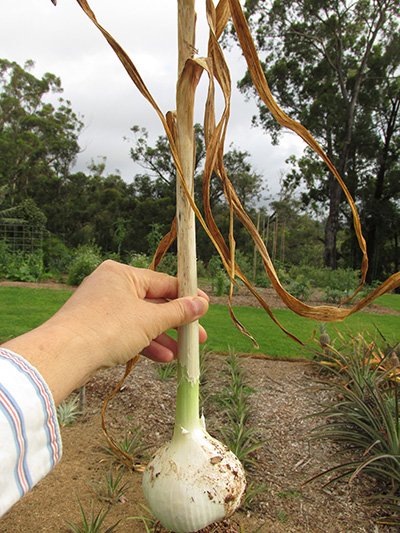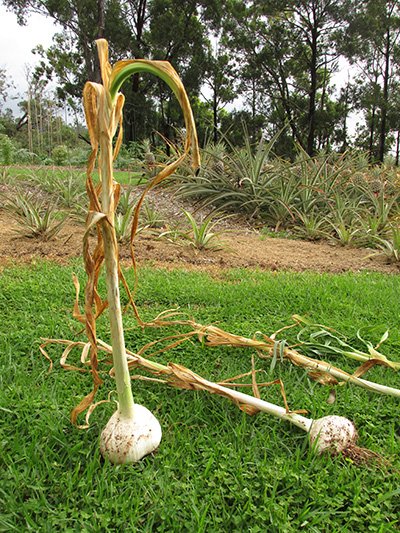Elephant Garlic is a fascinating allium family member with a much milder flavor than its regular-sized counterparts. This giant herb yields sizable and delectable bulbs that are ideal for roasting, grilling, or incorporating into your preferred cuisine. Elephant garlic is, admittedly, not true garlic, but it has many of the same properties and can be used in the same way.
Cultivating elephant garlic can be an enjoyable and fulfilling endeavor. By following some straightforward pointers, you can quickly savor the taste of fresh and delightful elephant garlic. For a garden filled with large purple flowers, and a cellar filled with bulbs to enjoy all year long, read on! Below, we'll tell you all about how to grow elephant garlic.
Botanical Name
Common Name
Plant Type
Mature Size
Sun Requirement
Soil Type
Hardiness Zone
Pet Friendly
Allium ampeloprasum var. ampeloprasum.
Elephant Garlic
Perennial
3-4 ft. tall, 1–2 ft. wide
Full sun
Loamy, well-drained
3–9 (USDA)
No
What Is Elephant Garlic?
Despite its common names of Elephant Garlic, Giant Garlic, and French Garlic, Allium ampeloprasum var. ampeloprasum is much more closely related to leeks than regular garlic. Because it is closely related to leeks, this plant has a gentle taste and a gradual process of bulb development. However, it looks like regular garlic that you could purchase at any grocery store!
You can tell the difference between regular garlic and elephant garlic by closely examining the bulb. The elephant garlic bulb is substantially large and is surrounded by a handful of separate cloves. Regular garlic doesn't have this central bulb, instead composed of multiple cloves clustered around a central stalk.
As elephant garlic bulbs grow, hollow spear-shaped leaves push through the top of the bulb and up through the soil. As the plant matures, flower stalks appear at the top of these leaves. At first, they are covered with a papery film, but they open into unique flowers of pink and purple. The flower stalks can reach 2 to 3 feet in height.
Elephant garlic takes two years to produce a full harvest, although it can be harvested the first year if desired. During its first year, the plant's resources will go into building up the single large bulb. If a larger single bulb is what is intended to be harvested, the elephant garlic can be dug up then. However, the second year of growth will see many leaves and stalks, which feed the development of multiple separate cloves around the central bulb.
Both the bulbs and the leaves of the elephant garlic plant are edible and delicious. The elephant garlic bulb can be roasted or sauteed to add to any number of dishes, and the leaves can be used in any recipe that calls for chives.
How To Grow Elephant Garlic
Plant Elephant Garlic
The best time to plant and grow elephant garlic is typically in the fall, between September and November, or in the early spring, between February and April. Growing elephant garlic during these months allows the garlic to establish a healthy root system before winter or the hot summer months. Planting in the fall also allows the garlic to go through a period of cold weather, which can stimulate bulb growth. However, the exact planting time may vary depending on your location and climate, so it's important to check with local gardening resources for the best planting time in your area.
When planting elephant garlic, start by separating the bulbs into individual cloves. Next, plant each clove pointed end up in a hole that's approximately 6 inches deep, leaving about 1 foot of space between each clove. After placing the cloves in the ground or container, cover them lightly with soil and water them.
Harvest Elephant Garlic
When your elephant garlic is ready to harvest will depend on when you planted them. Bulbs planted into early spring will be ready to harvest when summer heat sets in, although it will have only produced one bulb. Fall-planted garlic will be harvested in the succeeding summer, and the increased duration of its growth period will lead to a higher count of cloves.
You will know it is time to harvest elephant garlic when the leaves become yellow and fall over. Utilize a hand trowel or small shovel to loosen the bulb from the ground delicately. Use garden shears to cut away the leaves to a 1/2 inch above the garlic bulb. Wipe away any remaining soil using a dry cloth, and set the bulbs in a cool, dry location to cure. Curing elephant garlic bulbs will require anywhere from 3 to 8 weeks, depending on the humidity levels.
After the cloves have cured, remove any remaining roots and trim the stalk to approximately 2.5cm in length. Preserve your summer yield in a dry and cool area. Cured garlic will preserve for at least ten months, with the bulbs taking on a fuller flavor as time passes.
How To Care For Elephant Garlic
Light
Elephant garlic grows in full sun conditions, meaning they need to be planted in a location that receives at least 6 hours of direct sunlight each day. Elephant garlic can be planted in partial shade locations, but it will negatively affect the bulb size.
Water
Young plants should be watered every morning until they grow and become established in the soil. After that point, elephant garlic prefers 1 inch of water each week. Your weather patterns may take care of that for you, or you might have to water your plants using a garden hose or sprinkler system.
Take care not to overwater elephant garlic, and allow the soil around the elephant garlic bulb to dry out slightly between waterings.
If your elephant garlic has produced flowers and the leaves have started to turn yellow, this is not a sign that the plant is too dry and needs more water. Instead, it means it's almost time to harvest - so stop watering!

Source: Flickr
Temperature
Elephant garlic can be planted in either the fall or early spring, and it needs cool temperatures to grow.
These plants are robust and can be cultivated in USDA hardiness zones 3 to 9, meaning that they can endure chilly temperatures and scorching heat with adequate attention. Elephant garlic can survive temperatures as low as -20 degrees Fahrenheit. In these subzero conditions, the leaves will likely die away, but the bulbs will continue growing if mulched well. Elephant garlic overwinters well in these locations with harsh winters. In zones with milder winters, the garlic will naturally produce more frost-hardy leaves and will continue to grow as normal.
Proper mulching can help protect the bulb from heat waves as well. However, elephant garlic must receive at least six weeks of temperatures at or below 40 degrees Fahrenheit for the bulbs to develop.
Humidity
An overly humid environment can quickly lead to fungal diseases in elephant garlic. Weeks on end of high moisture conditions above 50% humidity will result in rotting bulbs. Planting your elephant garlic bulbs in well-draining soil with enough space to provide good air circulation should prevent high humidity conditions from causing harm.
Soil
The soil requirements for elephant garlic are similar to that for most garden plants. It's best to plant elephant garlic bulbs in fertile soil that drains easily and has a neutral pH. It's a wise idea to mix compost or other organic matter with your garden's well-drained soil. This large bulb will take significant nutrients out of the soil!
Fertilization
Fertilization is necessary in order to support the growth of this large plant. Its nutrient needs will also change depending on its stage of growth.
Elephant garlic will not flower during its first year of being planted. When you plant the large bulb, working compost into the soil is enough fertilization for this first year.
During the second year, top-dress the soil around the bulb with more compost. Then, as the foliage begins to appear, fertilize your elephant garlic with a high-nitrogen foliar feed (12-0-0 NPK) every two weeks.
When the stalks fall over, this signals that the plant is focusing its energy on bulb production. At this point, you'll need to stop applying the high-nitrogen fertilizer and switch to a high-phosphorus fertilizer (3-15-2 NPK) in powder form.
Pruning
It's not necessary to prune elephant garlic leaves until harvest begins. If you have many dead or damaged leaves, you can clip them away with garden shears to help encourage air circulation and keep moisture levels adequate.
Propagation
Propagating elephant garlic is easily achieved using individual cloves. Multiple cloves will be around the central bulb when an elephant garlic plant is harvested after its second year. Each clove can be replanted and grow into its own elephant garlic plant.

Source: Flickr
Common Problems When Growing Elephant Garlic
Elephant garlic plants aren't any more difficult to grow than true garlic, but you may have to contend with a few pests and diseases.
Pests
Most pests dislike the flavor and scent of alliums, so pests won't be a big concern. However, slugs will damage young plants and will make a meal of the elephant garlic scapes. Trap them by placing a small container of beer near your plants. The slugs will head there first and drown. You can also use copper tape to deter slugs.
Diseases
Fusarium root rot is a concern with elephant garlic plants. This fungal disease spreads from the bulb up to the leaves, turning them yellow and eventually covering them in a white fungus. While you can prevent this root rot by providing proper growing conditions, you cannot eradicate it once it has occurred. You will need to remove any plants showing evidence of fusarium root rot to prevent it from spreading to other plants.
Poor soil drainage
Elephant garlic prefers soil that drains well. If the soil is heavy or compacted, it can lead to waterlogged conditions that cause the roots to rot. To avoid this, it's important to plant elephant garlic in soil that has been amended with organic matter like compost or aged manure. Additionally, raised beds can be used to improve soil drainage.
Overwatering
Overwatering is a common problem with elephant garlic. The plants require regular moisture, but it is also crucial to allow the soil to dry out between watering intervals. If the soil remains continuously wet, it can result in rot and disease. To avoid this, water deeply but infrequently and only when the soil dries out.
Lack of nutrients
Elephant garlic requires a balanced fertilizer to grow properly. The soil should have adequate levels of nitrogen, phosphorus, and potassium, as well as other micronutrients like calcium and magnesium. Before planting, it is advisable to test your soil to identify if any modifications are required. A soil test will also give you an idea of the pH of your soil, which should be around 6.0 to 7.0 for optimal growth.
Improper planting depth
When sowing elephant garlic, it is recommended to bury it approximately 2-3 inches into the soil with the pointed end facing upward. Planting too shallowly may hinder the proper formation of bulbs, while excessively deep planting may cause the plants to fail to sprout. Be sure to space the cloves about 6 inches apart and water thoroughly after planting.
Is Elephant Garlic Pet Friendly?
According to the ASPCA, all members of the allium family are safe for pets to ingest. However, there is a strong voice in the veterinarian community that garlic and onions are not safe for dogs (specifically) to eat, even in small amounts. When growing elephant garlic in your garden, keep an eye on any canine companions you might have. If you find them eating some leaves, watch for adverse side effects that might occur as a result.
